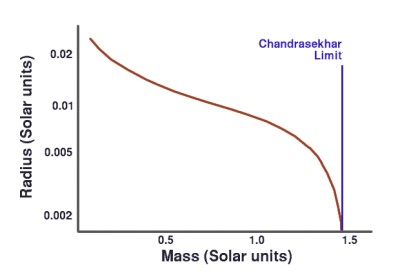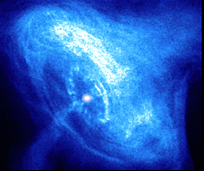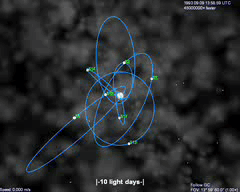Stellar Remnants
Page Contents
- Introduction
- White Dwarfs
- Planetary Nebulae
- Neutron Stars and Pulsars
- Supernova Remnants
- Black Holes
1. Introduction
While the "death" of a star may seem like the end of the story, there is still a lot of interesting physics to be learnt from the study of the remnants. Indeed, such "debris" are among the most studied objects in the sky. The most important remnants are White Dwarfs, Planetary Nebulae, Neutron Stars (and Pulsars), Supernova Remnants and Black Holes.
2. White Dwarfs
White dwarfs are the remnants left after the "death" of a star similar to the Sun (less than about 4 MSun). Although they have no more nuclear reactions in their cores, they start life at a very high temperature, since the collapse of the material down onto the core has converted a lot of gravitational potential energy into heat. White dwarf surface temperatures range from of 10,000 K to 100,000 K.

The White Dwarf Mass-Radius Relationship>
The Chandrasekhar Limit in WD mass is show.
Since there is no further generation of energy, you might expect that temperature to drop rapidly, but it does not work quite like that. White Dwarfs are, indeed, cooling down, but they are very small, and so have a low surface area. Because of this, their luminosity is very low (they are near the bottom of our typical HR diagram) and so they radiate the heat away very slowly - taking billions of years to cool down.
So why are they so small? As you may recall, as the core of a star collapses after running out of fuel for nuclear fusion, the material becomes degenerate. A white dwarf is simply this degenerate core. A typical white dwarf will be similar in size to the Earth but contain about as much mass as the Sun, giving densities of about 109 kg/m3 - about 200,000 times as dense as the Earth!
One rather strange consequence of the degenerate nature of white dwarfs is their strange Mass-Radius Relationship. The "normal" relationships between temperature, pressure and density do not hold for degenerate matter. In fact, as the mass of a white dwarf increases, its radius decreases. This is shown in the graph on the right. As you can see, there is a maximum mass beyond which the white dwarf becomes unstable. This limit was calculated by Subrahmanyan Chandrasekhar in the 1930s to be 1.4 MSun and is named after him.
3. Planetary Nebulae

The Ring Nebula (Messier 57)
A First Light image from the Liverpool Telescope
When the "dead" core of a Sun-like star becomes a white dwarf, the outer envelope of the star is left free to drift off into space. It is then heated by the radiation from the hot white dwarf and starts to glow. These glowing clouds are Planetary Nebulae or PNe. (Please note that they have very little to do with planets. They got their name as some PNe looked rather like slightly fuzzy planets in early telescopes).
Since the light from PNe is largely due to emission from atoms irradiated by ultra-violet light from the parent WD, the spectrum is dominated by emission lines. Special "narrow band" filters are often used to image PN as in the image from the Liverpool Telescope on the left.
In this image, the red colour comes from the hydrogen-α emission line at 656 nm and the green is light from the "forbidden" oxygen line [OIII] at 501 nm. An additional blue "broad band" filter was used to catch the light from the white dwarf which you can see in the centre of the nebula.
4. Neutron Stars and Pulsars

A Pulsar (rotating neutron star)
This simulation shows how the "beam" of a pulsar is swept past the observer giving a "flash".
Image courtesy of Matthew Bailes, Swinburne
As you have seen, when the mass of the "dying" star is significantly greater than that of the Sun, the collapse of the core does not stop at the degenerate-electron stage that leads to a white dwarf, but continues down to the even more compact neutron star.
Neutron stars are also degenerate, but with degenerate neutrons rather than degenerate electrons. Their density is comparable to that of an atomic nucleus at about 1017 kg/m3, giving a typical size of just 10s of kilometres! (To try and understand what this sort of density really means, bear in mind that a teaspoon-full of neutron star on the Earth would weigh a billion tonnes!).
Neutron stars are caused by the collapse of an object that is likely to be spinning, if only very slightly (it is very unlikely that a star could form in such as way as to have no spin). As it collapses, the angular momentum is conserved, and so the neutron star is rapidly "spun up". Typical rotation periods are from a couple of minutes right down to a milliseconds.
At the same time, the magnetic field of the parent star will be intensified, giving magnetic fields 1012 times that on the surface of the Earth.
Under these circumstances, the radiation emitted by the neutron star can be tightly "beamed" and the beam will then be swept across the sky rather like a cosmic lighthouse, as shown in the figure on the right.
If the beam points towards the Earth at some point, we will see a "flash" of light (usually radio, although other wavelengths have been seen including optical). Such objects are called Pulsars.
Pulsars

A Pulsar in X-rays
A "time-lapse" movie of the Crab pulsar observed by the Chandra X-ray satellite
Image courtesy of NASA
The discovery of pulsars is one of the most influential discoveries of the 20th century and attracted a lot of press attention at the time. Indeed, it makes a fascinating story.
In 1967 two Cambridge radio astronomers, Anthony Hewish and Jocelyn Bell, found a surprising periodic signal in the data from their new telescope. The were concerned at first, as the signal looked rather "man-made" consisting of pulses 3.7 seconds apart - far too periodic and even to be anything natural. Hewitt and Bell racked their brains for an explanation. The source was far too fast to be something like a pulsating star, and it could not be earthbound. Some of the more far-fetched suggestions included the idea of communication from a distant civilisation. Although they did not really believe in that possibility, Hewitt and Bell had to take it seriously. That they did so (and perhaps as indication of a rather cheeky sense of humour) is illustrated by the fact that the first four of these periodic sources were initially listed as LGM 1-4 (Little Green Men). Once several such objects were found the explanation of other civilisations seeking contact did, of course, become unreasonable. The paper detailing the discovery soon appeared in the journal Nature, and Anthony Hewish was awarded the Nobel Prize for the discovery of this new class of stars, the pulsars, in 1974.
Since the initial discovery, many pulsars have been found, and not just in the radio with optical pulsars seen and even X-rays detected from some.
The accuracy with which the timing of the "pulses" can be measured has allowed us to use pulsars as tests of some fundamental physics. In particular, General Relativity predicts a gradual slowing down of the pulsar as the angular momentum is lost due to the creation of "gravitational waves". Such waves have never been detected (although experiments are being built) but the measured slow-down of pulsars matches the prediction of Relativity to an astonishing level of precision.
| The radio signals produced by Pulsars can be easily converted in sounds that we can hear. Some examples are given here. |
5. Supernova Remnants
Like planetary nebulae, Supernova remnants (SNR) are formed from the outer envelope of the parent star. Unlike PNe, however, the shockwave, photon radiation and neutrinos of the supernova explosion have accelerated the gas to high velocities and heated it considerably.
The high-speed material continues out into interstellar space where it will encounter colder, slower material in the interstellar medium (ISM) and become broken up and distorted, leading to complicated and often very beautiful shapes.
Because of the high temperatures involved, young SNRs radiate across most of the electro-magnetic spectrum right up to X-rays. Indeed, SNRs have been found in nearby galaxies purely from their X-ray emission.
| You can see the "Crab" SNR across the electro magnetic spectrum here. |
As well as spreading "dredged up" heavy elements from the parent star into the ISM, the supernova shockwave can also lead to compression of nearby molecular clouds. This compression can then trigger further star formation - a process called "feedback". Since only the most massive stars go supernova, and since these are the shortest lived, once star formation starts within in a large molecular cloud, feedback can mean that it rapidly escalates to the entire cloud leading to bursts of rapid star formation. Understanding exactly how this process works is an important question in the study of galaxies and the formation of stars in the early universe and so has a direct effect on our understanding of Cosmology.
6. Black Holes
Probably the most enigmatic stellar remnant, and certainly the most famous are Black Holes - the delight of science fiction writers for decades!
Black holes are probably created in the most extreme supernova explosions. When the parent star is very massive (greater than perhaps 30 MSun), then even neutron degeneracy pressure is not enough to stop the collapse of the core and it shrinks down beyond the size of a neutron star. At this point there is no known physics that can stop the collapse and the objects becomes infinitely dense.
Since gravity increases as the inverse square of the distance from the centre of mass of an object, and since you can get very close to one of these collapsed stars, the gravitational force can be enormous. In fact, there comes a point (called the Event Horizon) where the force is so great that the escape velocity is greater than the speed of light.
Since nothing can travel faster than the speed of light, anything getting closer to the object than the event horizon can never escape - not even light itself, hence the name black hole.
Of course, that makes it very difficult to find black holes! However, it is possible to see the effect of the black hole on the stars and material around it. Gas, dust and even other stars near to a black hole may be pulled in by the gravity and crash into each other, producing energy. Because this happens away from the centre of the black hole, the light can escape and we can observe it. We can also look for objects that are orbiting something that is clearly massive, but which we cannot see.
There are many examples of both of these kinds of objects, including a "supermassive" black hole at the centre of the Milky Way.
Orbiting a black holeA video based on observations of the motion of stars right in the centre of the Milky Way is available here. The animation shows the actual movement of the stars as observed over a number of years and focuses on the very rapid motion of a star that clearly orbits around a massive, but invisible object.
Animation created by the Max-Planck-Society
|
If you want to know a bit more about black holes, Ted Bunn has written and excellent "FAQ" on them that you can see here.

